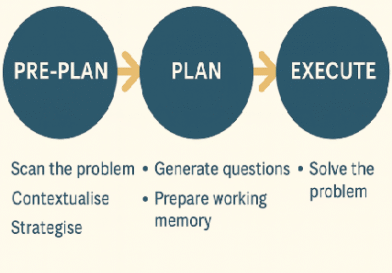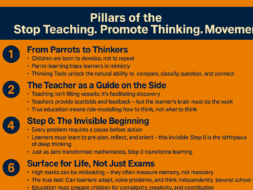Read this in conjunction with Pre-planning or Step 0 is a cognitive placeholder for thinking
Here is more helpful information Traditional Teaching Needs a Cognitive Defibrillator
How is it possible that a learner who gets extra lessons and practises lots of sums still performs poorly?
What we often forget is this: solving a problem in an exam is not the same as doing one in class.
In class or extra-class tutoring, learners rely on support—hints, examples, peer help, or short-term memory.
However, in the exam, that support is gone. It’s just the learner, the sum and the executive memory on an island of thinking to correctly do the sum. A lonely world with no scaffolds but Step 0
Executive memory is the brain’s planning and decision-making system. It helps the brain to organise, choose a strategy, and sequence steps.
Here’s the problem:
Teachers are under the impression that the more sums a learner do, the more they obtain pre-planning skills. This is not the case.
This means most learners have underdeveloped executive memory pre-planning skills.
Without pre-planning skills, planning and executing become reactive rather than strategic.
Learners end up solving without truly understanding, following steps without context, and reaching answers without clarity.
It's like navigating a maze by trial and error—every turn feels like a guess. Pre-planning is what transforms action into intention, and effort into effectiveness
So what happens?
Instead of planning a path through the sum, they:
- Panic
- Guess
- Or apply a procedure from memory—even if it’s wrong
Their brains, under pressure, skip the pre-planning phase entirely—and dive into solving. This is when something subtle but dangerous occurs:
⚠️ A Brain in Fibrillation
Just like a heart in fibrillation beats rapidly without rhythm or effectiveness, a brain in cognitive fibrillation is busy but disorganised.
- The learner misses the real context and becomes visually impaired to see obvious clues and critical information.
- The learner appears active—scribbling, calculating—but their thinking is chaotic.
This results in the following when executing of doing the sum:
- Steps are taken out of sequence.
- The actual question is misunderstood.
- Key details are ignored or misinterpreted.
This is not a motivation issue. It’s a skills gap.
It’s a missing mental discipline: they were never taught to pause, pre-plan, and activate clarity before executing. Over time, this constant confusion and cognitive overload lead to frustration—until the learner starts to believe “I’m just not good at maths.”
What begins as a skills gap quickly becomes an emotional block. And from there, it’s a short road to maths anxiety, avoidance, and even a lifelong dislike of learning anything that feels complex.
What is Pre-Planning in Maths
Pre-planning in maths is not about writing the first step.
It’s what happens before the pen touches the page.
It’s the learner’s mental scanning and audit of the sum—asking:
- “What kind of sum is this?”
- “What clues are given?”
- “Which laws and rules will assist me?”
- “Which answers do I already have?”
- “Which questions do I anticipate?”
- “Which other topics does this connect to that may be supportive?”
- “What might be the most efficient route to solve it?”
- “What do I expect the answer to look like?”
This is the mind grasping the context, visualising the pathway, and generating questions that will shape the plan.
From Chaos to Clarity: Pre-Plan → Plan → Execute
In maths, this three-phase flow is critical:
- Pre-Plan
A private brainstorm: scan the sum, spot patterns, ask strategic questions, prepare mentally. - Plan
Choose a path. Decide on steps. Mentally rehearse the method. - Execute
Confidently work through the sum—because the brain is already organised and ready.
Most learners only practise the third phase.
But without Phases 1 and 2, Phase 3 collapses under pressure.
Pre-Planning Is Multi-Dimensional Thinking
Pre-planning a maths sum is not only logical—it’s multidisciplinary cognition and metacognition in action:
- Linguistic clarity to decode the question
- Spatial insight to visualise structures and diagrams
- Memory recall to link concepts
- Auditory reasoning to “talk it through” mentally
- Emotional control to override stress and think clearly
It is visual and auditory closure, cognitive scanning, and executive questioning—all before doing anything.
It’s the ability to see both the visible and the invisible:
not just the numbers on the page, but the patterns behind them and the traps ahead.
Why We Must Teach It
To build problem solvers, we must teach more than procedures.
We must train learners to see the problem before they solve the problem.
That means:
- Modelling pre-planning aloud
- Using checklists that ask “What do I see? What do I expect?”
- Giving learners “pre-plan only” warmups
- Celebrating strategic thinking, not just correct answers
When we have developed a learner that can pause, look at a sum, and say,
“Before I start, let me figure out what this really is…”
is the moment they begin to think like a mathematician.
Final Thought
A learner who has done hundreds of sums but never learned to pre-plan is like a driver with a full tank, but no map.
They can drive fast—but have no idea where they’re going.
Pre-planning is the learner’s mental compass.
It’s what gives structure to effort, and meaning to action.
It’s not a luxury. It’s the starting point.
Let’s teach learners to pre-plan—
so they don’t just work hard in maths,
but work with vision, clarity, strategy, and control.
For more information and support contact Dr Cas Olivier





